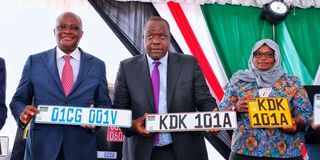New number plates: Is the pain worth it?

Then Transport CS James Macharia, then Interior CS Fred Matiangi, and PS Safina Kwekwe display newly launched number plates.
Is the changing the number plates on every car in Kenya going to fundamentally improve anything, or is it just more jibber-jabber for generating revenue or some other reason?
--Ngugi W.
Fair question. There is definite merit in upgrading the physical appearance of our number plates, but if that was the main or only reason for the current mammoth exercise it would be started with new registrations only, and then offered to any/all other already-registered vehicles as a voluntary upgrade. Ergo, no deadline shorter than a decade!
Clearly, there are more and weightier reasons than a cosmetic change. And, clearly, they are more than just additional information on the plate, which could be added with a sticker (as already successfully used in the past for road-tax verification).
My guess is that NTSA is conducting a ground-zero census of all the cars in Kenya, to try to unscramble decades of missing, inaccurate, incomplete or corrupted data. Leaving aside the chosen method of doing this, and how that method is implemented, and what it will cost, and how long it will take, and whether and how the improved data bank will be maintained and used, that is a massively valid and important objective.
Certainly, new plates will remedy the currently woeful and nationally embarrassing look of our current identifiers, with some reduction of their forge-ability. That alone will be a big win for both individual and national dignity.
But that is incidental to the primary purpose: To know exactly how many vehicles there are on our roads, of exactly what class, type, make model and age, and who they truly belong to.
The Kenyan National Bureau of Statistics (whose recording is not impeccable) needs to know that. So do the Treasury and KRA. And the Ministry of Transport. And the Ministry of the Environment. And potential investors. And existing motor businesses. And the police. And the media. And the public. And, increasingly, the Kenya Power!
Hitherto, this crucial data has been chaotic and impenetrable, leaving all interests – general or vested – to guess with margins of error often more than 100 percent. The very process of converting manual records to digital data has repeated inaccuracies and even added to them. And then, perhaps to the horror of administrators, computers have been able to spot and report (instantly and for the first time) exactly how many anomalies there are!
For better or for worse, NTSA have opted for universal change of number plates, and a process equivalent to re-registration, to sort this out. The method may be debatable, but the objective is absolutely valid and urgently necessary.
On behalf of all readers, I would stress that the overwhelming majority of vehicle owners are not to blame for the current condition of the statistics, so implementation (the process) of the new system should presume their innocence, clearly distinguish between technical oversight and wilful fraud, and minimise the cost in either cash or time.
In turn, I would urge vehicle owners to recognise the urgent need for and the ultimate long-term benefits of the objectives, and to try to find and tolerate the time the process takes (which is by far the biggest cost element).
With mutual respect and teamwork between officials and the public, this process can be a win-win. And the lessons of that example will be another long-term benefit.





